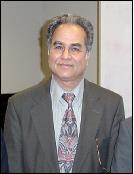Contribute
| Technology - Artificial Discs For The Aching Backs |
Vijay K. Goel
08/01/2004
(This article is sponsored by The Boston Group)
Pain and disability are the most common symptoms of arthritic joints caused by degeneration, inflammation or trauma. Fusion has been a common surgical procedure for painful arthritic joints. Successful fusion provided satisfactory relief of pain but with no joint motion. Even though fusion has been historically the standard orthopedic treatment for disabling arthritis of the hip and knee, it is seldom today performed. Total joint arthroplasty is clearly the standard. In the last few years, the enthusiasm for arthroplasty of the hip and knee as an alternative to fusion has been transferred to the painful lumbar disc degenerative disorders. Thus, the advances in the treatment of spinal disorders seem to follow the course for other joints as well.
For the painful low back, the lumbar disc and facet joints have become the focus of orthopedic treatment. If the young adult fails to reach an acceptable level of improvement with a comprehensive conservative program fusion has become a reasonable option. Fusion usually reduces the level of pain but often does not eliminate the need for pain medications and usually does not return the patient to unrestricted work or daily activities. Adjacent level degeneration is also believed to be problem after fusion surgery. Particularly in the lumbar spine where potentially significant forces are encountered, and load transfer to spinal segments adjacent to a fusion may not be optimal. These fusion related issues have led to the interest in disc arthroplasty technology as a viable treatment alternative. Thus, surgical treatment of degenerative disorders of the spine is about to repeat the successful revolution of joint arthroplasty of the hip and knee. Mechanisms of pain relief by artificial disc replacement are not well understood but are probably similar to other joint arthroplasties; removal of the pain source and restoration of joint function.
The total disc prosthesis replaces nucleus pulposus and annulus fibrosus or all three component-structures of a disc (the nucleus pulposus, the annulus fibrosus and the vertebral endplates). Currently, four LDR devices have IDE’s and are in different stages of the FDA regulatory process. The Medtronic Sofamor Danek “Maverick”,and the Spinecore “Flexicore” are both metal-on-metal. The DePuy-Spine “Charite III – Slip core” and the Synthes “Prodisc” are metal on poly. The metals that can be used are
medical grade stainless steels and Co-Cr alloys. The polymer is typically Ultra High Molecular Weight Polyethylene (UHMWPE).
Both the clinical and biomechanical issues are involved in the design and development of the artificial discs. The premise of artificial disc technology is that normal spinal kinematics will be restored and loads will be shared among the spinal segments. The hypothesis is that such a disc will inhibit the progression of spinal degeneration of the adjacent segments that is thought to accompany the spinal fusion.
The University of Toledo, under the direction of Dr. Goel and his associates (Drs. Cameron and Kapoor), is part of a statewide team that is working in the area of spinal implant development with integrated microelectronics to allow for sensing and wireless communication. The project, in collaboration with Theken Surgical, Inc., is to develop an artificial spinal disc that replicates human disc performance in terms of motion. The team serves a key role in the development of an embedded sensing package for inclusion in the disc design. The integrated sensors will be capable of measuring parameters such as force, temperature, and acceleration using state-of-the-art technology including some based on piezo-microlayers. The real-time data collected from the
sensors is then transmitted out of the body through an embedded micro-telemetry device that is also integrated as part of the spinal disc. This will enable the physician to check the status of the prosthesis during office visits and allow the patient to understand the effects of current lifestyle on implant longevity. Without a feedback mechanism, the physician can only recommend these changes to the patient, but has no ability to monitor the condition of the disc beyond simple, external techniques. The team will also help with the mechanical testing of the device.
You may also access this article through our web-site http://www.lokvani.com/

